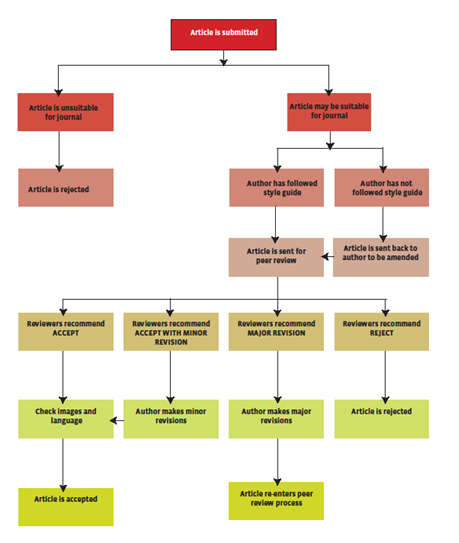- Submissions

Peer Review Process
The Peer Review is an assessment by an expert of material submitted for publication. The Peer Review Policy is the most essential tool in assessing the quality of publication process that analyzes, validates, and integrates new research findings. The peer review is a quintessential quality measure to prevent plagiarism. The reviewers have a very active role to play in the society by checking the bountiful scientific communication that is available. The procedure highlights the best papers for originality and importance. We, at the Crimson Publishers adopt Double-blind peer review. The peer reviewers ensure the previous research is acknowledged and help detect any possible plagiarism.
Once the reviewers are chosen, the confirmation letters are sent to initiate the process of the review procedure. The reviewers make sure that the review is completed in a mutually agreed time-frame and any delay in review is promptly intimated, and the issues that are encountered during the time of the review are communicated to the journal. Poorly constructed papers are rejected before being subjected to external peer review and the authors are provided guidelines as to how to write a research paper. If the research paper has substantial issue then the specialized translation service is recommended.
The editor contacting the reviewer directly renders it a more personalized touch, polite yet effective. The editor is notified of the reviewer’s decision when the abstract is sent before the review process even begins, helping the reviewer to take quick and informed decision. Once the review report is submitted, it is subjected to other procedures of review before being accepted. The Crimson Publishers follows the Double-blind peer refereeing which helps to alleviate the problem of devious means of refereeing. This process is ideal for eliminating any potential bias; further, it works well with the authors working in developing countries and for those who have ‘ordinary’ reputation.
The Editor properly furnishes the reviewer with the information comprising a policy on anonymity, a policy statement on whether all articles are sent out for review, information on the selection of the reviewers, the number of the reviewers, the protocol a referee is expected to follow, the criteria for publication evaluation, the basis for the final decision, the method adopted to convey referee’s remarks with the author, statement on conflict of interest, rejection rates and feedback to reviewers.
Peer Review Flowchart

Peer review is a positive process
Peer review is an integral part of scientific publishing that confirms the validity of the science reported. Peer reviewers are experts who volunteer their time to help improve the journal manuscripts they review-they offer authors free advice.
Through the peer review process, manuscripts should become:
- More robust: Peer reviewers may point out gaps in your paper that require more explanation or additional experiments.
- Easier to read: If parts of your paper are difficult to understand, reviewers can tell you so that you can fix them.
- More useful: Peer reviewers also consider the importance of your paper to others in your field. Of course, in addition to offering authors advice, another important purpose of peer review is to make sure that the manuscripts the journal eventually publishes are of high quality. If a journal publishes too many low-quality manuscripts, its reputation and number of readers will decline.
Editorial rejection
Your journal manuscript can be rejected if it:
- Lacks proper structure
- Lacks the necessary detail for readers to fully understand the authors' analysis
- Has no new science
- Does not clearly explain which parts of the findings are new science, versus what was already known
- Lacks up-to-date references
- Contains theories, concepts, or conclusions that are not fully supported by its data, arguments, and information
- Does not provide enough details about materials and methods to allow other scientists to repeat the experiment
- Lacks clear descriptions or explanations of:
- Hypotheses tested
- The experimental design
- Sample characteristics and descriptive statistics
- Describes poor experimental design, or faulty or insufficient statistical analysis
Revising
When revising your manuscript and responding to peer review comments:
- Address all points raised by the editor and reviewers
- Describe the revisions to your manuscript in your response letter
- Perform any additional experiments or analyses the reviewers recommend (unless you feel that they would not make your paper better; if this is the case, explain why in your response letter)
- Provide a polite and scientific rebuttal to any points or comments you disagree with
- Differentiate between reviewer comments and your responses in your letter
- Clearly show the major revisions in the text, either with a different color text, by highlighting the changes, or with Microsoft Word's Track Changes feature
- Return the revised manuscript and response letter within the time period the editor tells you
 a Creative Commons Attribution 4.0 International License. Based on a work at www.crimsonpublishers.com.
Best viewed in
a Creative Commons Attribution 4.0 International License. Based on a work at www.crimsonpublishers.com.
Best viewed in 



























 Editorial Board Registrations
Editorial Board Registrations Submit your Article
Submit your Article Refer a Friend
Refer a Friend Advertise With Us
Advertise With Us


